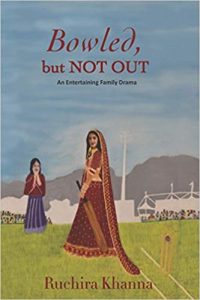Ruchira Khanna: Humor In Writing
I write contemporary fiction genre with themes that revolve around the facts of life.
Bowled but Not Out (BbNO) has a subject matter revolving around second chances. Often, an individual who has been let down the first time from a dysfunctional relationship will not have the courage to stand up and look out for another opportunity. Despair and discouragement will envelop her.
“If you want to tell people the truth, make them laugh; otherwise, they’ll kill you.”
― George Bernard Shaw
That’s when I thought of sprinkling humor in my protagonist’s life, Saru, by using cricket as a metaphor throughout the novel. I have projected Saru to be confident, empathic, funny, and silly at times. She bats away the sarcasm and negativity in the stadium that is her life.
Humor isn’t easy to define. While you know that comedy is a cognitive and emotional experience that often leads to laughter, you may not know why.
Why is something funny?
No one knows how to answer that question definitively. Humor is personal, subjective, and biased.
Humor is often the result of surprise. An unexpected action or phrase can be a delightful treat when set up in the right way.
“There is a thin line that separates laughter and pain, comedy and tragedy, humor and hurt.”
― Erma Bombeck
There is a thin line that separates laughter from pain. I embraced some tips to be able to make it an entertaining read.
1. Molded my protagonist to appear silly. I portrayed her as a die-hard Bollywood fan who would love to sing and dance around trees and even get emotionally charged if someone did a favor for her. This easy-going personality came in handy when I showcased her in a dysfunctional relationship. But then I also tried to have a character support her transition during that period and not give up.
2. Illustrating the comparison between two lives. One was the protagonist who had entered a dysfunctional relationship, and the other was her co-sister happily married. This contrast helps the reader get a grip on what my protagonist is going through, and it helps generate empathy for her.
3. Usage of metaphors to define her tragedies in addition to happy moments keeps the mood light. I used the terms of cricket to do the above.
Example: “Go and hit the ball out of the park.” Cheered Saru’s dad when they reached their destination. Saru realized that she had received a beamer and was quick to duck figuratively to avoid getting hurt. Her self-pride was bruised, but she continued to glare at the maid’s audacity.
4. I placed a character that a reader would love to hate. That prevents the plot from becoming too spicy and intense.
Example: “Just remember, Saru, the whole world will be watching you.” interjected mom as she got comfortable on the dining chair with the rotary phone on her lap.
“What a smart way to encourage your daughter, Sushma!” Her dad scorned his wife then inquired, “What are you doing?”
“I have to inform our relatives, Colonel. How will they know that our Saru is going to be on TV?”
5. Make them laugh when they least expect it. Never set the expectation that you’re about to try to be funny. It’s much easier to be funny unexpectedly. Make these attempts to be funny a subtle side effect; think of humor as a pleasant deviation from an expectation. Then create a scenario where laughter is induced skillfully.
Example: Saru goes for a TV interview, and things don’t go as planned. But she turns out to be everybody’s favorite towards the end.
I usually project the mental growth of my characters as they learn from their failures. And in my BbNO novel, I project the same. This young lady knows to groom herself to be a confident achiever and strengthen the platform for her daughter and her future.
The use of simple language, smooth transition of the story plot, humor, relatable and straightforward characters all make this book enjoyable and a must-read by one and all.
—
BOWLED, BUT NOT OUT
 What’s a girl to do when she wants to hit boundaries, but life throws her beamers? Saru expected her life to turn for the better when she found love and married. Instead, she kept getting deliberate yorkers from her mother-in-law. She hit a sixer when a baby arrived, but things got worse soon after. Her appeal to the umpire fell on deaf ears.
What’s a girl to do when she wants to hit boundaries, but life throws her beamers? Saru expected her life to turn for the better when she found love and married. Instead, she kept getting deliberate yorkers from her mother-in-law. She hit a sixer when a baby arrived, but things got worse soon after. Her appeal to the umpire fell on deaf ears.
Finally, she walked out of the stadium, and let go of the first love of her life. Then she flew off to New York for her Masters. Will Saru get a second chance at love and marriage and get to hit a century? Will her daughter ever form a relationship with her biological father? Bowled, but Not Out is an entertaining family drama full of heart and thoughtful life lessons and will resonate with anyone fond of cricket. Buy your copy now.
BUY HERE
Category: On Writing






























